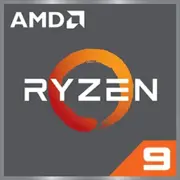AMD Ryzen 9 PRO 6950HS

AMD Ryzen 9 PRO 6950HS: Power and Efficiency in an Ultraportable Format
March 2025
Architecture and Process Technology: Zen 3+ and 6nm Technology
The AMD Ryzen 9 PRO 6950HS processor, released under the codename Rembrandt, is built on an enhanced Zen 3+ architecture and manufactured using TSMC FinFET 6nm process technology. This allows for a combination of high performance and energy efficiency, which is critical for mobile devices.
- Cores and Threads: 8 cores and 16 threads ensure parallel task processing. The base frequency is 3.3 GHz, with Turbo Boost reaching up to 4.9 GHz.
- Cache Memory: 16 MB of L3 cache accelerates data access, reducing latency in resource-intensive applications.
- Integrated Graphics: The Radeon 680M based on RDNA 2 architecture features 12 compute units (CUs) with frequencies up to 2.4 GHz. It supports ray tracing and FSR (FidelityFX Super Resolution) technologies, making it one of the most powerful integrated GPUs on the market.
Improvements over previous generations (such as the Ryzen 5000 series) include optimized power consumption, enhanced support for DDR5-4800 MHz, and PCIe 4.0.
Power Consumption and TDP: Balancing Power and Battery Life
With a TDP of 35W, the processor is designed for thin laptops and workstations where maintaining performance without overheating is essential. Thanks to the 6nm manufacturing process, the Ryzen 9 PRO 6950HS demonstrates 15-20% better energy efficiency compared to its 7nm counterparts.
- Power Management Technologies: AMD Precision Boost 2 dynamically adjusts frequencies, and PowerNow! algorithms lower voltage during idle states.
- Heat Dissipation: Even under peak loads, temperatures rarely exceed 85°C in well-designed cooling systems (e.g., Lenovo ThinkPad Z16 or ASUS ROG Flow X13).
Performance: Real-World Tasks and Turbo Mode
Geekbench 6:
- Single-Core Test: 1903 points — sufficient for instant responsiveness in browsers, office applications (Word, Excel), and light photo editing (Photoshop).
- Multi-Core Test: 8125 points — ideal for 3D model rendering (Blender), video encoding (HandBrake), or working with virtual machines.
Gaming:
- In Cyberpunk 2077 (1080p, low settings + FSR), the Radeon 680M achieves 45-55 FPS. For comfortable gaming in AAA titles, a discrete graphics card (like NVIDIA RTX 4060) will be needed, but the iGPU is sufficient for eSports (CS2, Valorant).
- In Turbo Boost mode, the processor temporarily boosts to 4.9 GHz, accelerating rendering by 10-15%, but increasing power consumption to 50W.
Multimedia:
- Converting 4K video in Premiere Pro takes 8-10 minutes, compared to 12-14 minutes for the Intel Core i7-1360P.
Use Cases: Who is the Ryzen 9 PRO 6950HS Suitable For?
1. Professionals: Designers, programmers, and engineers will appreciate multi-threaded performance in CAD applications (AutoCAD) and development environments (Visual Studio).
2. Hybrid Users: Those who balance work with gaming and streaming.
3. Students and Freelancers: Rapid data processing, streaming, and mobility.
Battery Life: How Long Will It Last?
Under moderate load (web surfing, YouTube):
- A laptop with a 75Wh battery lasts 8-10 hours.
In maximum performance mode (rendering):
- Battery life drops to 2-3 hours.
Energy-Saving Technologies:
- AMD Adaptive Power Management lowers the iGPU frequency during idle times.
- SmartShift redistributes power between the CPU and GPU, extending runtime.
Comparison with Competitors
1. Intel Core Ultra 7 155H (Meteor Lake):
- Similar multi-threaded performance, but Intel excels in AI-accelerated tasks (thanks to the NPU).
- Intel Xe-LPG iGPU is 25-30% weaker than the Radeon 680M.
2. Apple M3 Pro:
- Better energy efficiency (up to 12 hours of operation), but limited compatibility with Windows software.
3. Previous AMD Generations:
- Ryzen 9 6900HS on 6nm lags in multi-threaded performance by 7-10%.
Pros and Cons
Strengths:
- Best-in-class integrated graphics.
- High performance in multi-threaded tasks.
- Support for DDR5 and PCIe 4.0.
Weaknesses:
- Price: Laptops with this CPU cost $1400-2200.
- For AAA gaming, a discrete graphics card is still required.
Laptop Selection Recommendations
1. Device Type:
- Ultrabooks (e.g., HP EliteBook 845 G9): Focus on portability (weight up to 1.5 kg).
- Gaming Laptops (ASUS ROG Zephyrus G14): Additional discrete graphics and improved cooling.
- Workstations (Dell Precision 5570): Support for ECC memory and professional GPUs.
2. What to Look For:
- Cooling: Heat pipes and fans with adjustable speeds.
- Screen: For designers — 100% sRGB and brightness from 300 nits.
- Memory: Minimum of 16GB DDR5, with upgrade slots.
Final Conclusion
The AMD Ryzen 9 PRO 6950HS is an ideal choice for those who need mobility without compromises. It is suitable for:
- Professionals working with "heavy" software.
- Hybrid users balancing work and gaming.
- Anyone who values battery life and doesn't want to be tethered to a power outlet.
Key advantages include the Radeon 680M, support for the latest memory standards, and a sensible balance between power and energy consumption. If your budget allows, this processor will provide a reliable foundation for a laptop for the next 3-4 years.
Basic
CPU Specifications
Memory Specifications
GPU Specifications
Miscellaneous
Benchmarks
Compared to Other CPU
Share in social media
Or Link To Us
<a href="https://cputronic.com/en/cpu/amd-ryzen-9-pro-6950hs" target="_blank">AMD Ryzen 9 PRO 6950HS</a>